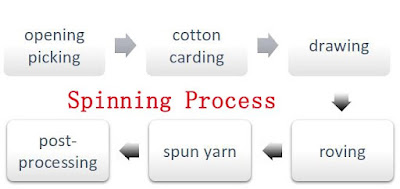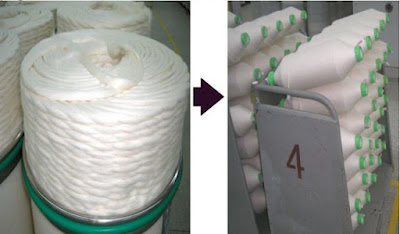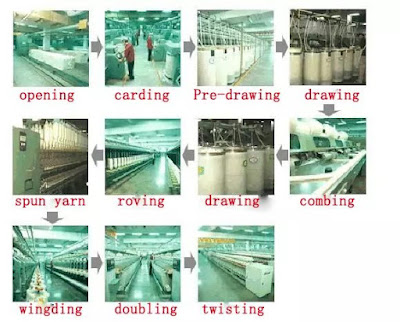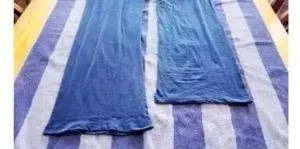Spinning Process Overview: From Fiber Material to Yarn
What is the Spinning Process?
Spinning is the act of taking animal fibers or vegetable fibres and twisting them to form a continuous, infinitely stretching yarn suitable for weaving. Simply put, it is the process of spinning fibres into yarn by mechanical means. Here, take the cotton fibres for example to illustrate the six processes involved in spinning.
opening picking
Opening | Loosening the lumpy fibres in a compacted chemical fibre bale into small pieces or small fibre bundles. |
Cleaning | Removal of some of the impurities from the raw material. |
Mixing | Mixing the fibres of various natures evenly. |
Evening and lap formation | To produce a homogeneous roll of chemical fibres for use in the carding process. |
cotton carding
Carding | obtaining single fibres |
Edulcoration | removal of faults and short staples |
Blending | blend single fibres |
Form sliver | making uniform slivers |
drawing
To improve the uniformity of the slivers, feed 6 to 8 slivers together into the draw frame and 1 synthetic sliver is obtained by roller drafting.
Main tasks:
Evenly | improving the uniformity of the sliver in order to obtain a more homogeneous and uniform yarn. |
Parallelism | making the fibres within the sliver straighter and more parallel. |
Blending | mixing the various fibres as required. |
Form sliver | forming the sliver into strips in the sliver drum for the next stage of production. |
roving
Drafting | draw the sliver into roving. |
Twisting | adding a certain amount of twist to the roving to increase its strength. |
Winding | the twisted roving is wound onto the barrel. |
spun yarn
Main tasks
Drafting | draft the roving to the required Tex number. |
Twisting | adding a certain amount of twist to the drafted yarn to give it a certain strength, elasticity and lustre. |
Winding | winding into a tubular yarn for transport and post-processing. |
post-processing
Main tasks
Stabilising the structure of the product. |
To change the inner properties of the product, improving the strength of the finished yarn by blending, twisting, etc. |
To improve the appearance of the product, removal of yarn faults and knotted impurities by burning, waxing, winding, etc. to improve uniformity and finish. |
Package the product in suitable forms for transport, storage and further processing, e.g. as a cylinder yarn, twisted yarn or in large or small packs. |
Twisting: Adding a certain amount of twist and processing it into strands.
Spinning process systems
In order to obtain yarns with different quality standards, different spinning methods and spinning systems should be adopted for different fibre materials. Here are a few common spinning systems and their processes, using cotton fibers as an example.
The raw materials used in cotton spinning production are cotton fiber and cotton-type chemical fiber, and its products include pure cotton yarn, pure chemical fiber yarn and various blended yarns. In the cotton spinning system, according to the quality of raw materials and yarn quality requirements, it can be divided into the general combing system, combing system and waste spinning system.
Carding spinning system
Generally used for spinning coarse and medium special yarn for weaving common fabric, the process and the name of semi-finished and finished products are as follows.
order | Opening picking ↓ | Cotton carding ↓ | drawing ↓ | roving ↓ | spun yarn ↓ |
product | carding sliver | Semi drawn sliver | drawn sliver | roving | spun yarn |
combing spinning system
The combing spinning system is used to spin high-grade cotton yarn, special yarn or cotton and chemical fiber blended yarn. The process of the combing system and the names of semi-products and finished products are as follows.
order | opening, carding ↓ | combing ↓ | drawing ↓ | roving ↓ | spun yarn ↓ |
product | carding sliver | combed bar | drawn sliver | roving | spun yarn |
Function: Further remove the knots, impurities and fiber defects in the fiber, exclude the short fibers below a certain length, improve the length, neatness and straightness of the fiber, stretch the sliver to the specified thickness.
Waste spinning system
The waste spinning system is used to process inexpensive coarse special cotton yarn, its process is as follows.
Opening picking → carding → roving → spun yarn
Chemical fiber and cotton blending spinning system
When polyester (or other chemical fibers) and cotton blending, because the polyester and cotton fiber properties and contains different, can not be mixed in the combing process, need to be made into strips, and then mixed in the first drawing frame, in order to ensure uniform mixing, it need to use three drawing. Its carding and combing spinning process is shown in the figure below.
Carding spinning system
cotton | opening, picking | pre-drawing | 3 mixed drawing | roving | spun yarn |
polyester | opening, picking | pre-drawing |
cotton | opening, picking | pre-combing | combing | 3 mixed drawing | roving | spun yarn |
polyester | opening, picking | pre-drawing | ||||











评论
发表评论